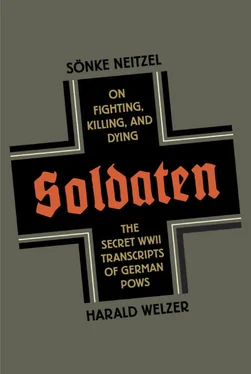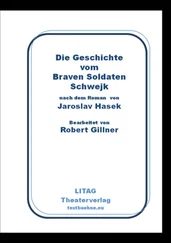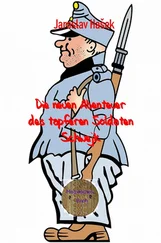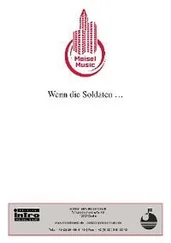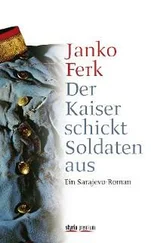Greiner, Krieg ohne Fronten, p. 249.
Reese, Mir selber, Schmitz, ed., p. 136ff.
The formation of groups also occurs on a more general level in the creation of borders between combat soldiers and the rest of the world. Biehl and Keller have described this phenomenon with reference to modern-day German Bundeswehr soldiers serving abroad: “The dialectic of soldiers’ latent ideology and their anti-ideological reflexes leads them to identify to a high degree with their mission and its aims. At the same time, they maintain a distanced and even negative attitude toward the media, society at large and leading politicians. Soldiers adopt an anti-elitist stance, in which they play the stylized role of people of action who get things done and upon whom the ultimate success of the mission depends. This mechanism helps them to deal with the stress and danger of their situation. In the process, the soldiers establish a black-and-white distinction between ‘us on the front lines’ and ‘them back home.’ These determine categories of belonging and respect.” Heiko Biehl and Jörg Keller, “Hohe Identifikation und nüchterner Blick,” in Auslandseinsätze der Bundeswehr: Sozialwissenschaftliche Analysen, Diagnosen und Perspektiven, Sabine Jaberg, Heiko Biehl, Günter Mohrmann, and Maren Tomforde, eds. (Berlin: Dunker and Humboldt, 2009), pp. 121–41, pp. 134–35. Maren Tomforde has examined the creation of a special identity among Bundeswehr soldiers serving in Afghanistan. For example, their pale pink tropical uniforms serve as a sign of group membership and distinguish them from members of other contingents. This leads to the creation of allegiances beyond their Bundeswehr identity during foreign deployments. Maren Tomforder, “‘Meine rosa Uniform zeigt, dass ich dazu gehöre’: Soziokulturelle Dimensionen des Bundeswehr-Einsatzes in Afghanistan,” in Afghanistan—Land ohne Hoffnung? Kriegsfolgen und Perspektiven in einem verwundeten Land, Vol. 30 Horst Schuh and Siegfried Schwan, eds. (Brühl: Die Deutschen Bibliotek, 2007), pp. 134–59.
A minority of soldiers, of course, do view their mission in terms of political goals and ideology to which they remain committed. One example are the veterans of the Abraham Lincoln Brigade, a troop of U.S. volunteers for the Spanish Civil War who were motivated by strong antifascist convictions when fighting the Nazis in World War II. See Peter N. Carroll et al., eds., The Good Fight Continues: World War II Letters from the Abraham Lincoln Brigade (New York: NYU Press, 2006).
Edelman, Dear America, p. 216.
Der Spiegel, 16/2010, p. 23.
Andrew Carroll, ed., War Letters: Extraordinary Correspondence from American Wars (New York: Scribner, 2002), p. 474.
Aly, Volksstaat .
Loretana de Libero, Tradition im Zeichen der Transformation: Zum Traditionsverständnis der Bundeswehr im frühen 21. Jahrhundert (Paderborn: Schoeningh, 2006).
See Benjamin Ziemann, Front und Heimat: Ländliche Kriegserfahrungen im südlichen Bayern 1914–1923 (Essen: Klartext, 1997).
Kühne, Kameradschaft, p. 197.
See Felix Römer, “Volksgemeinschaft in der Wehrmacht? Milieus, Mentalitäten und militärische Moral in den Streitkräften des NS-Staates,” in Welzer, Neitzel, and Gudehus, eds., “Der Führer.”
“The Story of M.I.19,” not dated, p. 1, TNA WO 208/4970; cf. Francis H. Hinsley, British Intelligence in the Second World War, Vol. 1 (London: Cambridge University Press, 1979), p. 283.
“The Story of M.I.19,” not dated, p. 6, TNA, WO 208/4970.
“The History of C.S.D.I.C. (U.K.),” not dated, p. 4, TNA WO 208/4970.
“Interrogation of Ps/W,” 17 May 1943, NARA, RG 38, OP-16-Z, Records of the Navy Unit, Tracy, Box 16: “Centres are, at present, established as follows: In England, 3 Centres for German & Italians, In North Africa, 2 Centres for German & Italians, In East Africa, 1 Centre (dismantled) for Japs, In India, 1 Centre for Japanese, In Australia, 1 Centre (A.T.I.S.) for Japanese, In U.S.A., 2 Centres for Germans, Italians and Japanese.”
For 3,838 German navy men, 4,826 surveillance protocols were made. The corresponding numbers for the Luftwaffe were 3,609 and 5,795; for the army (including the Waffen SS), 2,748 and 1,254. In addition, there are 2,076 protocols that record the words of members of different military branches. Protocols concerning army men were labeled S.R. The reports S.R.M. 1–1264 take up five files (TNA, WO 208/4136–4140); those concerning Luftwaffe men (S.R.A. 1–5836), nineteen; and those concerning navy men (S.R.N. 1–4857), seventeen. The mixed protocols S.R.X 1–2141 fill seven folders (TNA, WO 208/4158–4164); and those concerning staff officers and generals SRGG 1–1350; GRGG 1–363, eleven (WO 208/4165–4170, 4178, 4363–4366).
Neder, Kriegsschauplatz Mittelmeerraum, p. 12ff.
See Report of the Activities of Two Agencies of the CPM Branch, MIS, G-2, WDGS, o.D. (1945), NARA, RG 165, Entry 179, Box 575.
On the scope and history of the files, see “Study on Peacetime Disposition of ‘X’ and ‘Y’ Files,” no date, in Memorandum of the WDGS, Intelligence Division, Exploitation Branch, 14 March 1947, NARA, RG 319, Entry 81, Box 3.
See Römer, “Volksgemeinschaft in der Wehrmacht?”.
See PAAA, R 41141.
OKW A Ausl./Abw.-Abt. Abw. III No. 4091/41 G vom 11 June 1941, BA/MA, RM 7/3137.
Generalstabsoffizier No. 1595/43 gKdos, 4 November 1943, BA/MA, RL 3/51. We owe this reference to Klaus Schmider, Sandhurst.
See SRN 4677, March 1945, TNA, WO 208/4157. On cautionary warnings not to reveal sensitive information, see extract from S. R. Draft No. 2142, TNA, WO 208/4200.
See SRN 185, 22 March 1941, TNA, WO 208/4141; SRN 418, 19 June 1941; SRN 462, 28 June 1941, TNA, WO 208/4142; SRN 741 10 January 1942, TNA, WO 208/4143.
See SRM 741, 4 August 1944, TNA, WO 208/4138.
There is only one verified case of POWs discovering a concealed microphone. Extract from Draft No. 2148, 5 March 1944, TNA, WO 208/4200.
On interrogation strategies, see Neitzel, Abgehört, pp. 16–18.
Forty-nine informants were used in British surveillance camps. They reported on 1,506 POWs. Hinsley, British Intelligence, Vol. 1, p. 282ff. See CSDIC (UK), p. 6, TNA, WO 208/4970.
See the interrogation reports on Lieutenant Max Coreth, 18 March–22 May 1944, NARA, RG 165, Entry 179, Box 458.
See Falko Bell, “Großbritannien und die deutschen Vergeltungswaffen: Die Bedeutung der Human Intelligence im Zweiten Weltkrieg” (Master’s thesis, University of Mainz, 2009); Falko Bell, “Informationsquelle Gefangene: Die Human Intelligence Großbritannien,” in Welzer, Neitzel, Gudehus, eds., “Der Führer.”
Читать дальше
